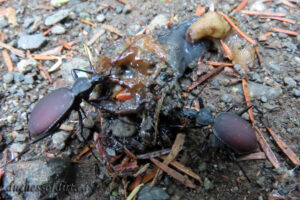|
Days to Maturity: 85 – 95 days
Seed Life: 5 years
Description: Small, teardrop-shaped variety of hubbard squash. Hard, thin exterior skin is bright orange in colour. Inner flesh is creamy yellow in colour and has a sweet, nutty flavour. Plant needs some room to sprawl.
Special Notes: Developed on the island of Hokkaido from American hubbard squash introduced to Japan in 1878. Today ‘Uchiki Kuri’ squash has become popular in Germany, (where it is known as ‘Hokkaido’), France (where it is called ‘Potimarron’), Holland, England and North America.
How to Grow: Prepare the planting area by digging a hole roughly 12 inches (30 cm) deep and filling it with well-aged manure. Place soil from the dug hole overtop, mounding it about 6 to 8 inches 15 – 20 cm) high. This will increase drainage as well as keep the squash plants well-fed.
For an early start, sow seeds indoors about 4 weeks before your last frost date or direct sow in the ground from mid-May through to mid-June. If growing seedlings indoors, harden them off for 1 – 2 weeks before transplanting them outside. Allow roughly 4 square feet (0.37 square meters) between plants.
Special Growing Notes: Select planting site carefully. ‘Uchiki Kuri’ squash prefer full sun, but they will do well with a minimum of 6 hours. Direct seed outdoors when soil temperature reaches 18 °C (65 °F) and soil is partially moist but not soggy. Wet soil may promote fungus growth on seeds and rot them. Allow 4 square feet (0.37 square meters) between plants to accommodate their sprawling growth habit. Also allow for good air flow between plants to discourage powdery mildew.
Germination takes about 10 – 14 days. Watch for slug, snails and cutworms once seedlings emerge from the ground.
‘Uchiki Kuri’ squash matures roughly 85 – 95 days after plant starts to bloom. The fruit is ready for harvesting when the rind end has hardened and the stem is about 2 inches (2.5 cm) long. If you harvest the fruit before it is mature, it will lose its sweet flavour. Cut ripe squash off the plant with a knife, being sure to leave 2 inches of stem intact. Harvest before the temperature falls. Harvest all of the fruits before a heavy frost hits the plants.
Cure squash in full sun for about 10 days. If freezing weather is in the forecast, move them into a covered area and move them out into the sun the next day. When fully cured, store squash in a dark room at about 10 °C (50 °F) and at less than 65% humidity. Cured and stored properly, they will last well into the winter.
How to Use: ‘Uchiki Kuri’ squash may be baked, boiled, steamed, fried and sautéed. The best part about this squash is its skin. Once cooked, the skin becomes soft and blends well. It does not require any peeling. This squash is highly nutritious; a good source of fibre, vitamins A, C and B, as well as calcium, potassium, iron, riboflavin and thiamine.
Pests & Diseases: Potential insect pests include: aphids, cucumber beetles, squash bugs, stink bugs, cutworms, pickleworm and squash vine borers. Slugs and snails could also be problematic. Some diseases to watch out for are: bacterial wilt, fusarium wilt, blossom end rot, downy mildew and powdery mildew.
In our Zone 7a garden: I grew this lovely little winter squash in an extra-large pot on our driveway in 2017. I was intrigued by its heirloom status, small size and nutty flavour. There were not a lot of squash on the one plant come end of season. Proved the claim from one reference that each plant will only produce 3 to 5 fruits. So, if you have to feed a large family, you will want to plant more than one ‘Uchiki Kuri’ plant. But I was very pleased with the sweet, nutty flavour of this squash and can recommend growing this variety.
Note: I used my favourite cooking method for winter squash…cut in half, seeds removed, placed cut side down in a baking dish and baked in the oven.
Posted on August 19, 2020
|





